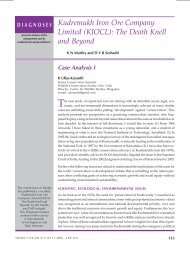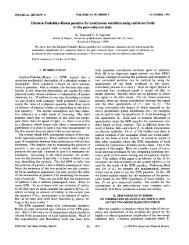Phase Transfer Catalysis - Publications of the IAS Fellows
Phase Transfer Catalysis - Publications of the IAS Fellows
Phase Transfer Catalysis - Publications of the IAS Fellows
You also want an ePaper? Increase the reach of your titles
YUMPU automatically turns print PDFs into web optimized ePapers that Google loves.
Catalyst<br />
Ammonium salts<br />
Phosphonium salts Costlier than<br />
ammonium salts<br />
Table 1. Commonly Used PT Catalysts<br />
cost Stability and Activity Use and Recovery <strong>of</strong> Catalyst<br />
Cheap Moderately stable under basic conditions Widely used. Recovery is relatively<br />
and up to 100% Decomposition by H<strong>of</strong>- difficult.<br />
mann elimination under basic conditions.<br />
Moderately active.<br />
More stable <strong>the</strong>rmally than ammonium<br />
salts, although less stable under basic conditions.<br />
Crown e<strong>the</strong>rs Expensive Stable and highly active catalysts both under<br />
basic conditions and at higher temperatures<br />
up to even 150-2OOT.<br />
Cryptands<br />
PEG<br />
Expensive<br />
Very cheap<br />
Stable and highly reactive,<br />
presence <strong>of</strong> strong acids.<br />
More stable than quaternary<br />
salts, but lower activity.<br />
catalysts based on optically active amines like ephedrine, chinine,<br />
or o<strong>the</strong>r cinchona alkaloids are widely used (Bhattacharya<br />
et al., 1986). TDA-1 (tris(3,6-dioxahelptyl) amine),<br />
syn<strong>the</strong>sized by Rhone-Poulenc, is a stable and effective PT<br />
catalyst for solid-liquid reactions, stable both under strongly<br />
basic conditions, and at high temperatures (Lavelle, 1986).<br />
Brunelle (1987) reported <strong>the</strong> use <strong>of</strong> a novel high-temperature<br />
PT catalyst, EtHexDMAP (N-alkyl salt <strong>of</strong> 4-dialkylaminopyridine)<br />
for polymers and monomer syn<strong>the</strong>sis. Idoux and<br />
Gupton (1987) report <strong>the</strong> use <strong>of</strong> polymer bound PT catalysts<br />
with more than one PTC site on <strong>the</strong> polymer. Similar multisite<br />
PT catalysts can also be syn<strong>the</strong>sized in <strong>the</strong>ir soluble nonpolymeric<br />
forms from simple polyhalo substrates. Balakrishnan<br />
and Jayachandran (1995) recently reported <strong>the</strong> use <strong>of</strong> a<br />
new rnultisite diammonium dichloride as a PT catalyst in <strong>the</strong><br />
addition <strong>of</strong> diochloro-carbene to styrene. Advantages <strong>of</strong> a<br />
multisite catalyst include higher catalytic activity per gram <strong>of</strong><br />
catalyst used, milder conditions, and less contamination <strong>of</strong><br />
product. Shaffer and Kramer (1990) report a special combination<br />
<strong>of</strong> PTC with inverse PTC (Section on PTC in <strong>the</strong> Industry)<br />
for polymerization reactions called bimechanistic PTC<br />
where an ammonium salt was used to mediate transfer from<br />
<strong>the</strong> aqueous phase to <strong>the</strong> organic phase while a cyclic or an<br />
acyclic sulfide like tetrahydrothiophene served as an independent<br />
catalysts for <strong>the</strong> organic to aqueous phase transfer.<br />
Choice <strong>of</strong> PT catalyst<br />
Two basic requirements <strong>of</strong> a PT catalyst (Starks and Liotta,<br />
1978) are:<br />
l The PT agent must be cationic and must have enough<br />
organic structure to be able to partition <strong>the</strong> nucleophilic an-<br />
ion into <strong>the</strong> organic phase.<br />
l The cation-anion bonding should be Zoose enough to ensure<br />
high anionic reactivity.<br />
Factors relevant in choosing a PT catalyst are stability under<br />
reaction conditions, ease <strong>of</strong> preparation or availability <strong>of</strong><br />
catalyst, ease <strong>of</strong> separation or recovery, activity and toxicity.<br />
Although no definite guidelines can be given to select <strong>the</strong><br />
best catalyst for a given reaction system, analysis based on<br />
some <strong>of</strong> <strong>the</strong>se factors can provide a suitable methodology to<br />
except in <strong>the</strong><br />
ammonium<br />
Widely used. Recovery is relatively<br />
difficult.<br />
Often used. Recovery is difficult and<br />
poses environmental issues due to<br />
<strong>the</strong>ir toxicity.<br />
Used sometimes despite high costs<br />
and toxicity, due to higher reactivity.<br />
Often used. Can be used when larger<br />
quantities <strong>of</strong> catalyst cause no problems.<br />
Relatively easy to recover.<br />
screen different PT catalysts for a given system. We compare<br />
here crown e<strong>the</strong>rs and cryptands, quaternary onium salts, and<br />
PEGS in terms <strong>of</strong> costs, toxicity, and stability with respect to<br />
temperature and basic conditions.<br />
PEGS are <strong>the</strong> cheapest while crown e<strong>the</strong>rs and cryptands<br />
are <strong>the</strong> most expensive <strong>of</strong> <strong>the</strong> commonly used PT catalysts.<br />
Crown e<strong>the</strong>rs and cryptands, besides <strong>the</strong>ir high costs, are also<br />
toxic, and are to be avoided whenever possible (if sufficient<br />
reactivity is possible using a quat or PEGS). Quaternary ammonium<br />
salts are usually useful in neutral or acidic media up<br />
to 100 - 15O’C. Dequaternization <strong>of</strong> <strong>the</strong> quaternary onium salt<br />
by <strong>the</strong> reverse Menshutkin reaction occurs at elevated temperatures<br />
in nonbasic media. PEGS, crown e<strong>the</strong>rs, and<br />
cryptands are more stable at higher temperatures and can be<br />
used up to temperatures <strong>of</strong> 150- 2OO’C. However, it should<br />
be noted that many applications <strong>of</strong> PTC require temperatures<br />
<strong>of</strong> 50 - 12O’C and quaternary onium salts are highly active,<br />
stable, and widely applicable under <strong>the</strong>se conditions.<br />
Crown e<strong>the</strong>r, cryptands, and PEGS also show higher stability<br />
to basic conditions than quaternary onium salts. In <strong>the</strong> presence<br />
<strong>of</strong> bases like 50% NaOH, quatemary ammonium salts<br />
decompose by H<strong>of</strong>mann elimination, yielding <strong>the</strong> corresponding<br />
trialkyl amine and an alkene (Zerda et al., 1986). Also, in<br />
<strong>the</strong> presence <strong>of</strong> s<strong>of</strong>t nucleophiles like RF, RsC-, R2Ne,<br />
RW, nucleophilic sNz displacement on <strong>the</strong> quat cation is<br />
possible, liberating trialkyl amine as <strong>the</strong> leaving group and<br />
alkylating <strong>the</strong> nucleophile (Dou et al., 1977). PEGS are good<br />
alternatives to onium salts as cheap and stable PT catalysts in<br />
reactions in basic media and at elevated temperatures. However,<br />
in comparison to crown e<strong>the</strong>rs, ctyptands, and onium<br />
salts, larger quantities <strong>of</strong> PEG are required due to <strong>the</strong>ir lower<br />
activity, though recovery via distillation is easily accomplished<br />
(Totten and Clinton, 1988).<br />
In summary, in terms <strong>of</strong> activity, stability, widespread availability<br />
and applicability, and costs, quatemary onium salts,<br />
(generically represented at Q+X- ), are <strong>the</strong> most cost-effective<br />
and feasible PT catalysts and are <strong>of</strong>ten <strong>the</strong> catalysts <strong>of</strong><br />
choice in industrial applications. PEGS have great potential<br />
but suffer from lower applicability due to <strong>the</strong>ir lower activity.<br />
Crown e<strong>the</strong>rs and cryptands can be used when both onium<br />
salts and PEGS are not useful, but <strong>the</strong>ir toxicity and higher<br />
costs are usually a deterrent to industrial applications.<br />
AIChE Journal March 1998 Vol. 44, No. 3 615
















